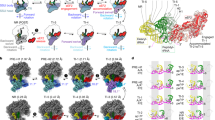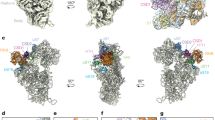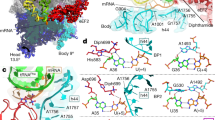Abstract
Messenger RNA (mRNA) homeostasis represents an essential part of gene expression, in which the generation of mRNA by RNA polymerase is counter-balanced by its degradation by nucleases. The conserved 5′-to-3′ exoribonuclease Xrn1 has a crucial role in eukaryotic mRNA homeostasis by degrading decapped or cleaved mRNAs post-translationally and, more surprisingly, also co-translationally. Here we report that active Xrn1 can directly and specifically interact with the translation machinery. A cryo-electron microscopy structure of a programmed Saccharomyces cerevisiae 80S ribosome–Xrn1 nuclease complex reveals how the conserved core of Xrn1 enables binding at the mRNA exit site of the ribosome. This interface provides a conduit for channelling of the mRNA from the ribosomal decoding site directly into the active center of the nuclease, thus separating mRNA decoding from degradation by only 17 ± 1 nucleotides. These findings explain how rapid 5′-to-3′ mRNA degradation is coupled efficiently to its final round of mRNA translation.
This is a preview of subscription content, access via your institution
Access options
Access Nature and 54 other Nature Portfolio journals
Get Nature+, our best-value online-access subscription
$29.99 / 30 days
cancel any time
Subscribe to this journal
Receive 12 print issues and online access
$189.00 per year
only $15.75 per issue
Buy this article
- Purchase on Springer Link
- Instant access to full article PDF
Prices may be subject to local taxes which are calculated during checkout




Similar content being viewed by others
References
Parker, R. RNA degradation in Saccharomyces cerevisae. Genetics 191, 671–702 (2012).
Nagarajan, V. K., Jones, C. I., Newbury, S. F. & Green, P. J. XRN 5′→3′ exoribonucleases: structure, mechanisms and functions. Biochim. Biophys. Acta 1829, 590–603 (2013).
Jones, C. I., Zabolotskaya, M. V. & Newbury, S. F. The 5′→3′ exoribonuclease XRN1/Pacman and its functions in cellular processes and development. Wiley Interdiscip. Rev. RNA 3, 455–468 (2012).
Roy, B. & Jacobson, A. The intimate relationships of mRNA decay and translation. Trends Genet. 29, 691–699 (2013).
Schmidt, C. et al. The cryo-EM structure of a ribosome-Ski2-Ski3-Ski8 helicase complex. Science 354, 1431–1433 (2016).
Hu, W., Sweet, T. J., Chamnongpol, S., Baker, K. E. & Coller, J. Co-translational mRNA decay in Saccharomyces cerevisiae. Nature 461, 225–229 (2009).
Antic, S., Wolfinger, M. T., Skucha, A., Hosiner, S. & Dorner, S. General and microrna-mediated mrna degradation occurs on ribosome complexes in Drosophila cells. Mol. Cell Biol. 35, 2309–2320 (2015).
Pelechano, V., Wei, W. & Steinmetz, L. M. Widespread co-translational rna decay reveals ribosome dynamics. Cell 161, 1400–1412 (2015).
Yu, X., Willmann, M. R., Anderson, S. J. & Gregory, B. D. Genome-wide mapping of uncapped and cleaved transcripts reveals a role for the nuclear mrna cap-binding complex in cotranslational rna decay in Arabidopsis. Plant Cell 28, 2385–2397 (2016).
Tat, T. T., Maroney, P. A., Chamnongpol, S., Coller, J. & Nilsen, T. W. Cotranslational microRNA mediated messenger RNA destabilization. eLife 5, e12880 (2016).
Gamble, C. E., Brule, C. E., Dean, K. M., Fields, S. & Grayhack, E. J. Adjacent codons act in concert to modulate translation efficiency in yeast. Cell 166, 679–690 (2016).
Tsuboi, T. et al. Dom34:hbs1 plays a general role in quality-control systems by dissociation of a stalled ribosome at the 3′ end of aberrant mRNA. Mol. Cell 46, 518–529 (2012).
Jinek, M., Coyle, S. M. & Doudna, J. A. Coupled 5′ nucleotide recognition and processivity in Xrn1-mediated mRNA decay. Mol. Cell 41, 600–608 (2011).
Chang, J. H., Xiang, S., Xiang, K., Manley, J. L. & Tong, L. Structural and biochemical studies of the 5′→3′ exoribonuclease Xrn1. Nat. Struct. Mol. Biol. 18, 270–276 (2011).
Ben-Shem, A. et al. The structure of the eukaryotic ribosome at 3.0 A resolution. Science 334, 1524–1529 (2011).
Dehecq, M. et al. Nonsense-mediated mRNA decay involves two distinct Upf1-bound complexes. EMBO J. 37, e99278 (2018).
Cesena, D. et al. Regulation of telomere metabolism by the RNA processing protein Xrn1. Nucleic Acids Res. 45, 3860–3874 (2017).
Medina, D. A. et al. Cytoplasmic 5′-3′ exonuclease Xrn1p is also a genome-wide transcription factor in yeast. Front. Genet. 5, 1 (2014).
Orban, T. I. & Izaurralde, E. Decay of mRNAs targeted by RISC requires XRN1, the Ski complex, and the exosome. RNA 11, 459–469 (2005).
Li, Y., Yamane, D. & Lemon, S. M. Dissecting the roles of the 5′ exoribonucleases Xrn1 and Xrn2 in restricting hepatitis C virus replication. J. Virol. 89, 4857–4865 (2015).
Chapman, E. G., Moon, S. L., Wilusz, J. & Kieft, J. S. RNA structures that resist degradation by Xrn1 produce a pathogenic Dengue virus RNA. eLife 3, e01892 (2014).
Pijlman, G. P. et al. A highly structured, nuclease-resistant, noncoding RNA produced by flaviviruses is required for pathogenicity. Cell Host Microbe 4, 579–591 (2008).
Ikeuchi, K. et al. Collided ribosomes form a unique structural interface to induce Hel2-driven quality control pathways. EMBO J. 38, e100276 (2019).
Mangus, D. A. & Jacobson, A. Linking mRNA turnover and translation: assessing the polyribosomal association of mRNA decay factors and degradative intermediates. Methods 17, 28–37 (1999).
Beckmann, R. et al. Architecture of the protein-conducting channel associated with the translating 80S ribosome. Cell 107, 361–372 (2001).
Zheng, S. Q. et al. MotionCor2: anisotropic correction of beam-induced motion for improved cryo-electron microscopy. Nat. Methods 14, 331–332 (2017).
Zhang, K. Gctf real-time CTF determination and correction. J. Struct. Biol. 193, 1–12 (2016).
Kimanius, D., Forsberg, B. O., Scheres, S. H. & Lindahl, E. Accelerated cryo-EM structure determination with parallelisation using GPUs in RELION-2. eLife 5, e18722 (2016).
Ben-Shem, A., Jenner, L., Yusupova, G. & Yusupov, M. Crystal structure of the eukaryotic ribosome. Science 330, 1203–1209 (2010).
Brown, A. et al. Tools for macromolecular model building and refinement into electron cryo-microscopy reconstructions. Acta Crystallogr D Biol Crystallogr. 71, 136–153 (2015).
Pettersen, E. F. et al. UCSF Chimera—a visualization system for exploratory research and analysis. J. Comput. Chem. 25, 1605–1612 (2004).
Goddard, T. D. et al. UCSF ChimeraX: meeting modern challenges in visualization and analysis. Protein Sci. 27, 14–25 (2018).
Acknowledgements
The authors thank S. Rieder, H. Sieber and C. Ungewickell for technical assistance, and T. Fröhlich and M. Kösters for mass-spectrometry analysis. This work was supported by German Research Council (FOR1805 and BE1814/15-1), the Center for Integrated Protein Science Munich (CiPS-M), the ANR-17-CE11-0049-01 grant, the Pasteur Institute and the Centre National de la Recherche Scientifique.
Author information
Authors and Affiliations
Contributions
Experiments were performed by P.T., E.H. under the supervision of T.B. and R.B., and by M.F.-R. and A.J. P.T. and E.H. prepared samples for cryo-EM and P.T., E.H. and L.K. processed the data. P.T., E.H. and T.B. analysed the cryo-EM data. J.C. built the molecular models and P.T., R.Bu. and T.B. refined them. A.J. performed Northern blots and Xrn1 mutant strain construction and M.F.-R. characterized the effects of the mutant Xrn1. P.T., T.B. and R.B. wrote the manuscript. R.B., T.B., A.J. and M.F.-R. conceived the study and designed the experiments.
Corresponding authors
Ethics declarations
Competing interests
The authors declare no competing interests.
Additional information
Publisher’s note: Springer Nature remains neutral with regard to jurisdictional claims in published maps and institutional affiliations.
Integrated supplementary information
Supplementary Figure 1 Activity test of Xrn1-TAP and purification of the 80S–Xrn1 complex.
(a) Schematic representation of the reporter mRNA construct used for in vitro translation. A stalling sequence consisting of a (CGA-CCG)2 tandem di-codon was placed downstream of a sequence encoding for truncated ribosomal protein uL4 preceded by a TEV-cleavable His6-tag for purification and a HA tag for immunoblotting. (b) Ni-NTA affinity purification of RNCs followed by immunoblotting by anti-HA antibody. One hundredth of each fraction was loaded except for elution (1/250). Peptidyl-tRNA identity was confirmed by RNAse and puromycin treatments. (c) Northern Blot for RPL28 mRNA in yeast cultures expressing wild type and TAP tagged Xrn1 compared to deletions of UPF1 and XRN1. Note that the RPL28 mRNA is degraded by wild type Xrn1 and Xrn1-TAP whereas it accumulates in UPF1 and XRN1 knockouts. (d) UV260 profiles of sucrose density-gradients after His-HA-uL4-RNCs affinity purification: RNCs were purified after in vitro translation under low-salt conditions using magnetic Dynabeads (see Methods) and eluates were subjected to sucrose density gradient centrifugation. (e) The 80S peak from the gradient was harvested, pelleted through a sucrose cushion and applied to SDS-PAGE. Protein bands were cut out and subjected to mass spectrometry, by which Xrn1, heat shock proteins (Hsps) and ribosomal proteins were identified (for details see Supplementary Tables 2 and 3).
Supplementary Figure 2 3D classification of the 80S–Xrn1 cryo-EM dataset.
1,633,111 particles were initially separated into eight classes partly representing different translational states of the ribosome. 60 % of the particles containing tRNAs in the P- and E sites were joined and separated into two classes with and without Xrn1 (highlighted in blue throughout the figure). The class containing Xrn1 was refined to an overall resolution of 3.1 Å after post-processing followed by a two-step focused classification using a soft mask for the Xrn1 density. The final Xrn1-containing class was focused-refined to a resolution of 3.6 Å.
Supplementary Figure 3 Local resolution, refinement and model statistics.
Cryo-EM density maps filtered and colored according to local resolution as estimated by ResMap with Fourier Shell Correlation (FSC) plots for the refined 3.1 Å ribosome–Xrn1 map (a) as well as the focused refined 3.6 Å Xrn1 map (b). (c) FSC plot of the ribosome–Xrn1 model against cryo-EM maps as calculated by REFMAC. FSCWork represents the FSC of the model refined against half map 1, compared to half map 1. FSCFree represents the FSC of the model refined against half map 1, compared to half map 2 and FSCAverage represents a global measure of the fit to the density.
Supplementary Figure 4 Fitting of molecular models of ribosome, Xrn1 and mRNA into the cryo-EM density maps.
(a) Overview of the fitted S. cerevisiae Xrn1 model into the isolated focused-refined Xrn1 density. (b) Model for 17 ± 1 nucleotides of the reporter mRNA from the P-site through the mRNA exit site into the catalytic core of Xrn1 fitted into the ribosome–Xrn1 map (density of mRNA was isolated). P- and E-site tRNAs as well as ribosomal proteins eS26, eS28 and uS11 are shown for clarity. (c) Fit of the Xrn1 helix α4 (‘tower helix’) into isolated density showing the presence of most side chains. Side chains with missing density are colored in white. (d-e) Fit of the Xrn1 catalytic core with mRNA substrate. (d) First three 5’ mRNA bases are stably bound within Xrn1 forming a continuous π-π stack, with His41 capping the 5’ base and Trp638 the third base. (e) Note the Xrn1 N-terminus is packing against the phosphate backbone of the mRNA and terminal 5’P is in contact with two Mg2+ ions.
Supplementary Figure 5 Domain composition and evolutionary features of Xrn1.
(a) Scheme highlighting the strictly structure-based domain composition of S. cerevisiae Xrn1. Parts missing in the ribosome-bound Xrn1 are indicated as dashed line. (b) Model of ribosome-bound S.c. Xrn1 color coded for domains according to the diagram in (a). (c-d) Overlays of the S.c. Xrn1structure with D. melanogaster Xrn1 (c) and the K. lactis Xrn1 (d). KOW, SH3-like and winged helix domains are not visible in the ribosome-bound Xrn1 structure. The 60S ID interspersing the two conserved regions (CR) is missing in the D. melanogaster structure and is rearranged with respect to the K. lactis structure. (e) Ribosome-bound S.c. Xrn1 colored according to sequence identity 10–100% based on multiple sequence alignment (Supplementary Note 1). The 60S ID is the most evolutionarily variable domain in the structure. (f) Excerpt of the secondary structure diagram of S. cerevisiae 28S rRNA showing expansion segment ES31a (highlighted in blue). Structural model below shows the S.c. ribosome–Xrn1 complex. (g) Secondary structure scheme of the D. melanogaster ES31a (highlighted in blue) and the structure of D. melanogaster ribosome with superimposed S.c. Xrn1. 60S ID domain would clash with long ES31a indicating co-evolution of Xrn1 with its rRNA interaction partner.
Supplementary Figure 6 Structure comparison of ribosome-bound Xrn1.
Comparison of the S.c. ribosome–Xrn1 complex (a) with unbound D. melanogaster Xrn1 structure superimposed on the S.c. ribosome (b). Three loops engaged in interactions with ribosomal components are depicted (L1 = 119–129, L2 = 46–56, L3 = 227–244) as well as the potential clash of the superimposed Winged helix domain with ribosomal protein eS28.
Supplementary Figure 7 Xrn1-mEGFP validation.
(a) Northern Blot for RPL28 mRNA in yeast cultures expressing either wild type Xrn1 (WT), Xrn1-mEGFP or no Xrn1 expression (xrn1Δ). Pre-mRNA of RPL28 is efficiently processed by Xrn1-mEGFP comparable to wild type. (b) The histogram represents the mean ratio (for three biological replicates) of RPL28 pre-mRNA over total (pre-mRNA + mRNA) for the wild-type reference strain BY4742, the Xrn1-mEGFP mutant and the xrn1∆ mutant, quantified from a northern blot analogous to the one presented in Supplementary Fig. 1c. Error bars represent the standard deviations. (c) Fluorescence microscopy of yeast wild type cells (WT) compared with Xrn1-mEGFP strain.
Supplementary information
Supplementary Figures, Supplementary Tables, Supplementary Notes and Supplementary Dataset
Supplementary Figures 1–7, Supplementary Tables 1–2, Supplementary Notes 1–4 and Supplementary Dataset 1
Rights and permissions
About this article
Cite this article
Tesina, P., Heckel, E., Cheng, J. et al. Structure of the 80S ribosome–Xrn1 nuclease complex. Nat Struct Mol Biol 26, 275–280 (2019). https://doi.org/10.1038/s41594-019-0202-5
Received:
Accepted:
Published:
Issue Date:
DOI: https://doi.org/10.1038/s41594-019-0202-5
This article is cited by
-
Atlas of mRNA translation and decay for bacteria
Nature Microbiology (2023)
-
RNA-controlled nucleocytoplasmic shuttling of mRNA decay factors regulates mRNA synthesis and a novel mRNA decay pathway
Nature Communications (2022)
-
Structures of the eukaryotic ribosome and its translational states in situ
Nature Communications (2022)
-
Xrn1 is a deNADding enzyme modulating mitochondrial NAD-capped RNA
Nature Communications (2022)
-
A distinct mammalian disome collision interface harbors K63-linked polyubiquitination of uS10 to trigger hRQT-mediated subunit dissociation
Nature Communications (2022)



